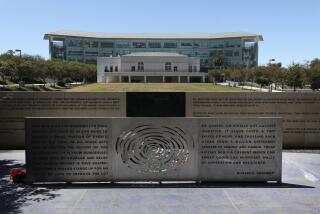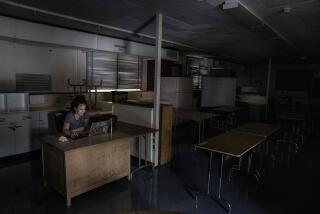Schools Turn to New Law to Levy Fees on Developers
- Share via
Several South Bay school districts are moving quickly to take advantage of a new state law that allows them to assess fees on new residential, commercial and industrial developments. Others are holding back until the legislation, little noticed when it was hastily adopted late last year, is better understood.
The new law, which started out as AB 2926 authored by Assemblyman Larry Stirling (R-San Diego), is included in a larger package called the School Facilities Act of 1986. The purpose of Stirling’s legislation is to tap additional sources of revenue to help finance construction and renovation of school facilities during an era of burgeoning student population in California, county education officials say.
Most South Bay districts are struggling with a different problem--declining enrollment and shrinking resources. They hope the new law will direct some money their way to refurbish old buildings that have deteriorated in recent years for lack of maintenance by the financially strapped districts.
Critics of the new law generally see it as a way to raise new taxes in the guise of fees.
Bureaucrats’ Ploy
“I think it’s another ploy by the bureaucrats in Sacramento to circumvent the will of the people as expressed in Proposition 13,” said Ron Faktor, sales manager for Blackmore Associates, a Torrance-based developer.
He and other developers said the fees--up to $1.50 per square foot for new homes and additions and 25 cents per square foot for commercial and industrial developments--would be passed on to consumers.
Before 1978, a school district figured out its spending needs each year and routinely tacked the bill to the county property tax rate. Then along came Proposition 13, the Jarvis-Gann tax-cutting initiative, and suddenly the schools--and other local governing agencies--were shorn of their authority to impose taxes unless two-thirds of the voters approved in advance.
Existing property taxes were slashed, leaving the schools largely dependent on the state for their financial needs. School officials say the state has not been a good and reliable provider.
Now comes the new law from Sacramento that authorizes school districts to impose fees--generally defined as an assessment to finance a specific public service--on new homes and businesses. But the school districts won’t get to keep or spend the fees. The new law calls on them to turn the money over to the state, which will add it to a kitty earmarked for school construction.
“I guess, in a sense, we’re being asked to serve as revenue collectors for the state,” said Ed King, business manager for the South Bay Union High School District. “The law came as a surprise and we’re still studying it.”
Still, King’s district is among many that are moving ahead to enact the fees because of a quid pro quo feature involving an earlier piece of legislation, the 1976 LeRoy Greene School Facilities Act. It goes like this, according to Matthew Spies, an analyst in the county superintendent’s office:
If a school district assesses the developer fees and turns the money over to Sacramento, the state will add it to funds from other sources and send the district a check to cover the cost of a project approved under the Greene act. If the district fails to enact the fees, then the amount it could have collected will be deducted from its Greene grant. Spies said a building that the district wants to renovate must be at least 30 years old to qualify for Greene money. If the building is newer than that, he said, the district can still raise money to renovate it by assessing developer fees.
District Keeps Money
In that case, the district can keep and spend the fees, but the state will not contribute any money to the project, he said. Spies said Stirling’s legislation grew out of concerns over how to finance statewide needs for new and improved school facilities. The overall cost of keeping up with rising enrollment, he said, has been estimated at $5 billion.
“At the last minute in 1986, there was an effort to pull together elements from a number of prior bills that tried to address the funding problem,” he said. “The new law is what Sacramento came up with, and we understand there will be a number of trailer bills intended to clarify the law.”
One aspect in need of clarification, he said, is whether overlapping school jurisdictions, such as elementary and high school districts, can each assess the new fees, leading to multiple assessments on the same developments.
Spies said the county superintendent’s office is advising the districts to split the fees to minimize chances of lawsuits from developers.
The county’s advice is apparently being taken by South Bay districts planning to enact the fees. Hawthorne Elementary and the Centinela Valley Union High School districts, for example, are planning to split their fees, with 65% going to the grade school system and the rest to Centinela.
More Students
Hawthorne Supt. Roger Bly said his 5,140-student district has been growing in the last few years, generally as a result of new apartment and condo construction.
“We have already purchased six relocatable classrooms and we are going to need more space to keep up,” he said. “We also have some rather urgent needs for upgrading some of our older buildings.”
Robert Church, Centinela Valley’s business manager, said his district isn’t growing but still has a multimillion-dollar need for renovating old buildings.
“We understand that if we don’t assess the fees, we will be penalized in terms of funding we may get under the Greene act,” Church said.
Church said the district’s other three feeder systems--the Wiseburn, Lennox and Lawndale elementary districts--have not yet decided whether to go for a share in the fees.
Some ‘Hanging Back’
Unified districts in Torrance, El Segundo and on the Palos Verdes Peninsula are among school systems “sort of hanging back until we get a better feel for the lay of the land,” as one official put it.
Nancy Mahr, a spokeswoman for the Peninsula district, said the staff there is preoccupied with preparations for a parcel-tax election in March and hasn’t given too much thought to the new fee route for raising money.
El Segundo Supt. Richard Bertain said consideration of fees there is being balanced against “strong support we are already getting” from developers and corporations in the area. Imposing the fees does not appear likely at this point, he said.
Bertain observed that school boards generally were happy that Sacramento seemed to be moving in the direction of giving schools more local control over their financing. But, he added, the uncertainty over who will actually collect and spend the money appeared to be a case of giving with one hand and taking back with the other.
Lobbying Effort Planned
Spokesmen for the California Building Industry have said that the group plans an intensive lobbying effort in Sacramento to try to limit the scope of the new school fees. But local developers contacted by The Times generally expressed resignation to the turn of events.
“It all came as a shock,” said Guy Hocker, a Hawthorne developer and real estate agent. “But it’s the law now, and the fees will just have to be passed through to the consumer in the form of higher rents or higher price tags on new buildings.” If the maximum fees are imposed--as most districts apparently intend to do--the extra cost for a 3,000-square-foot home, for example, would be $4,500.
Neil Gascon, a partner in Gascon Mar Ltd., a San Diego-based developer with major projects under way on the east side of Torrance, expressed sympathy for the plight of school districts in the Proposition 13 era.
“To the extent that new construction creates a need for more school services, I think the building industry has to shoulder its share of the cost and consider it part of the cost of doing business,” he said.
However, he added, “it is patently unfair” to new home buyers who may be paying disproportionately more for the costs of education in their communities.
Gascon said the potential effect of the new fees on commercial development is not yet clear, since the relationship between the construction and greater school needs may be more difficult to establish.
Spies, the county analyst, said it’s up to the school districts to show that the relationship exists, both for residential and commercial construction. Otherwise, he said, the income would be classified as a new tax, which would be banned under Proposition 13 without that two-thirds voter approval.
More to Read
Sign up for Essential California
The most important California stories and recommendations in your inbox every morning.
You may occasionally receive promotional content from the Los Angeles Times.










